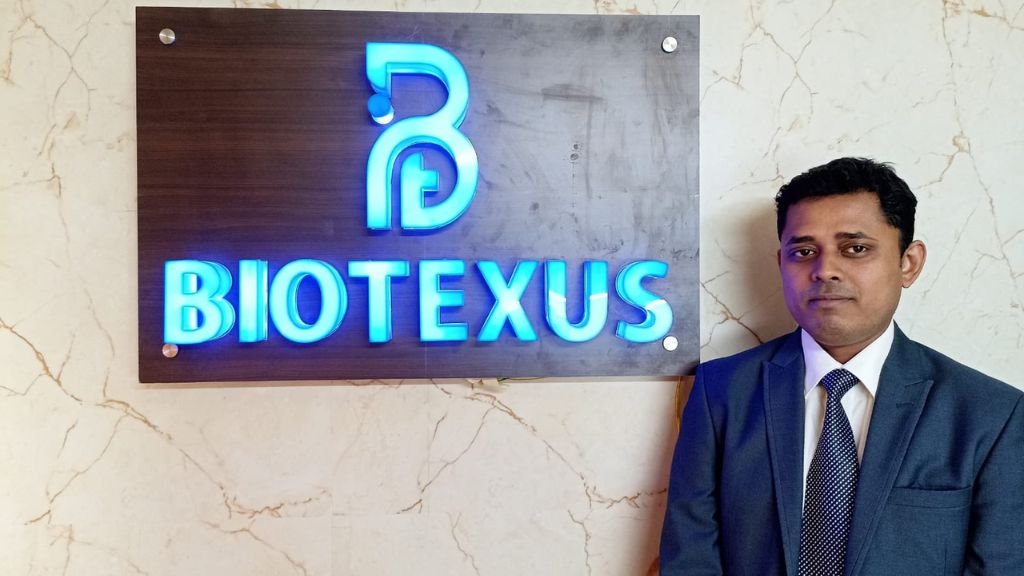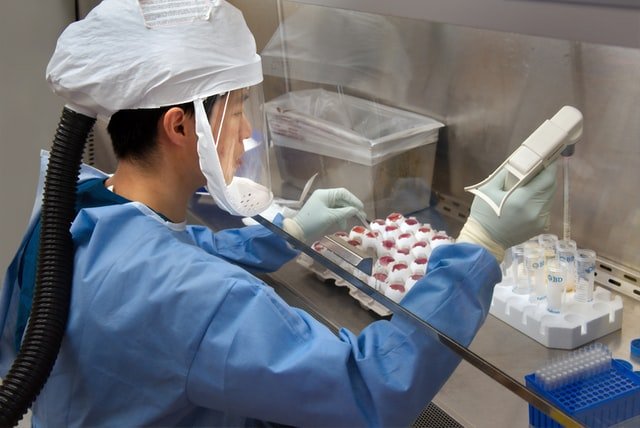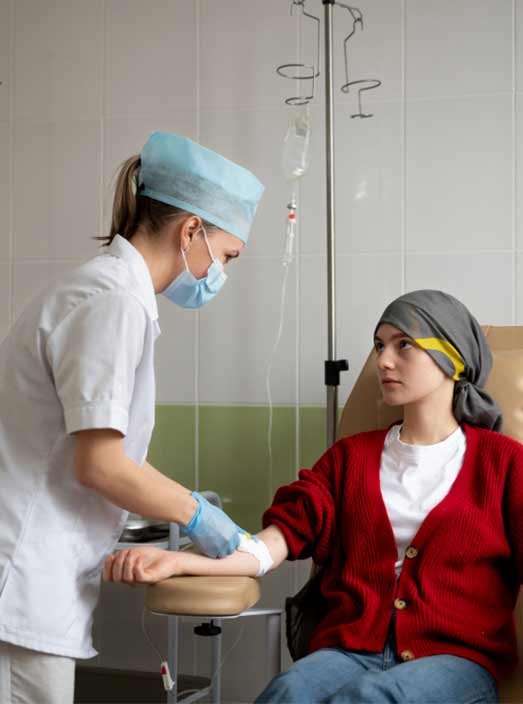Thyroid Cancer
- Biotexus
- September 12, 2025
About the thyroid
Thyroid cancer begins in the thyroid gland. This gland is located in front of the neck, just below the larynx, called the larynx. The thyroid gland is part of the endocrine system that regulates hormones in the body. The thyroid gland absorbs iodine from the bloodstream to produce thyroid hormone, which regulates human metabolism.
The normal thyroid gland has two lobes, one on each side of the trachea, connected by thin pieces of tissue called the isthmus. A healthy thyroid is almost imperceptible. In other words, it is difficult to find by touch. Swelling or enlargement of the thyroid gland is called goiter and can occur when iodine is deficient. However, most Americans get enough iodine from salt, and goiter in these situations is caused by other reasons. When a tumor develops in the thyroid gland, it is recognized as a lump in the neck.
About thyroid tumors
Thyroid cancer develops when healthy thyroid cells alter and grow out of control, generating a mass known as a tumor. The thyroid gland is made up of two types of cells:
Follicular cells : These cells are in charge of producing thyroid hormone. Thyroid hormone is required for survival. The hormone regulates the body’s fundamental metabolism. It regulates the rate at which calories are burnt. This can effect weight loss and gain, slow or quicken the heartbeat, increase or reduce body temperature, influence how fast food travels through the digestive tract, govern how muscles contract, and how quickly dead cells are replaced.
C cells : These thyroid cells produce calcitonin, a hormone that aids in calcium metabolism.
A tumor might be malignant or benign. A malignant tumor is one that can develop and spread to other regions of the body. A benign tumor is one that can grow but does not spread. Thyroid tumors are also known as nodules, and around 90% of thyroid nodules are benign.
Types of thyroid cancer
Papillary thyroid cancer : Papillary thyroid cancer begins in follicular cells and grows slowly. Thyroid cancer is the most prevalent form. It is often seen in one lobe. Only 10% to 20% of papillary thyroid cancers occur in both lobes. It is a differentiated thyroid cancer, which means that under a microscope, the tumor resembles normal thyroid tissue. Papillary thyroid carcinoma frequently spreads to the lymph nodes.
Follicular thyroid cancer : Follicular thyroid cancer arises from follicular cells and progresses slowly. Although follicular thyroid cancer is a kind of differentiated thyroid cancer, it is significantly less prevalent than papillary thyroid cancer. Lymph nodes are seldom involved in the spread of follicular thyroid carcinoma.
Hurthle cell cancer : Hurthle cell cancer, also known as Hurthle cell carcinoma, is a kind of cancer that starts from a specific type of follicular cell. Hurthle cell tumors are considerably more likely than other follicular thyroid tumors to metastasize to the lymph nodes.
Medullary thyroid cancer (MTC) : MTC originates in C cells and is occasionally caused by the genetic condition known as multiple endocrine neoplasia type 2. (MEN2). This tumor bears little resemblance to normal thyroid tissue. MTC is frequently treatable if detected and treated early.
Anaplastic thyroid cancer : This kind is uncommon, accounting for just around 1% of thyroid cancer cases. It is a rapidly growing, poorly differentiated thyroid cancer that can develop from either a differentiated or benign thyroid tumor. Anaplastic thyroid carcinoma can be classified into large cell subtypes. This form of thyroid cancer is more difficult to cure because it develops so fast.
Symptoms
It is common for people with thyroid cancer to have few or no symptoms or signs. A symptom is something that only the person experiencing it can identify and describe, such as fatigue, nausea, or pain. A sign is something that other people can identify and measure, such as a fever, rash, or an elevated pulse. Together, signs and symptoms can help describe a medical problem. Thyroid cancers are often diagnosed by routine examination of the neck during a general physical exam. They are also unintentionally found by x-rays or other imaging scans that were performed for other reasons. People with thyroid cancer may experience the following symptoms or signs. Sometimes, people with thyroid cancer do not have any of the signs and symptoms described below. Or, the cause of a symptom or sign may be a medical condition that is not cancer.
- A lump in the front of the neck, near the Adam’s apple
- Hoarseness
- Swollen glands in the neck
- Difficulty swallowing
- Difficulty breathing
- Pain in the throat or neck
- A cough that persists and is not caused by a cold
Treatment
Treatment options and recommendations depend on several factors, including the type and stage of thyroid cancer, possible side effects, patient preferences and general health.
Lobectomy : The malignant nodule in the thyroid gland is removed during this procedure.
Near-total thyroidectomy : This procedure, also known as a subtotal thyroidectomy, removes everything but a little portion of the thyroid gland.
Total thyroidectomy : The whole thyroid gland is removed during this procedure.
A thyroidectomy can be performed using a variety of surgical procedures, including :
Standard thyroidectomy : A minor incision (or cut) around the base or centre of the neck is made by the surgeon. This allows the surgeon immediate access to the patient’s thyroid gland during the procedure. Newer surgical procedures are being given at certain cancer clinics to lessen or prevent neck scars.
Thyroidectomy by endoscopy : The physician makes a single tiny incision during this surgery. The treatment is comparable to a regular thyroidectomy, except that instead of surgical loupe magnification, which is specialized eyewear, a scope and video monitor are used to guide the procedure.
Thyroidectomy with a robot : The surgeon creates an incision somewhere else, such as an armpit, the hairline of the neck, the mouth, or the chest, and then performs the thyroidectomy with a robotic instrument. Thyroid cancer patients should avoid robotic thyroidectomy.
Hormone treatment
Patients undergoing surgery usually require thyroid hormone therapy. In addition to replacing the hormones that the body needs, thyroid hormone drugs can slow the growth of the remaining differentiated cancer cells.
Radioactive iodine (radioiodine) therapy
Almost majority of the iodine that enters the body is absorbed by the thyroid. As a result, radioactive iodine (commonly known as I-131 or RAI) radiation treatment can locate and eliminate thyroid cells that have not been eradicated by surgery or that have migrated outside the thyroid.
External-beam radiation therapy
Another kind of radiation therapy is external-beam radiation, in which high-energy x-rays are delivered from a machine outside the body to eliminate cancer cells.
Therapies using medication
Medication-based treatments are used to kill cancer cells. Medication can be delivered through the circulation to cancer cells all throughout the body. Systemic treatment refers to the administration of a medicine in this manner. Medication can also be administered locally, which means that it is delivered directly to the malignancy or is retained in a certain portion of the body.
The types of medications used for thyroid cancer include:
- Chemotherapy
- Targeted therapy
Chemotherapy
Chemotherapy is the use of medications to eradicate cancer cells, often by preventing cancer cells from growing, dividing, and proliferating. A chemotherapy regimen, or schedule, typically consists of a predetermined number of cycles administered over a predetermined time period. A patient may be administered one medicine at a time or a mixture of drugs at the same time.
Targeted therapy
Targeted therapy is a type of cancer treatment that targets specific genes, proteins, or the tissue environment that contributes to cancer development and survival. This method of therapy inhibits cancer cell growth and spread while limiting harm to normal cells.
Risk
Gender : Three out of every four thyroid cancers are found in women.
Age : Thyroid cancer can strike at any age, although those between the ages of 20 and 55 account for almost two-thirds of all occurrences. Anaplastic thyroid carcinoma is typically detected beyond the age of 60.
Genetics : Some kinds of thyroid cancer are genetically predisposed. The following are some important information concerning this disease, genes, and family history.
Radiation exposure : Moderate radiation exposure to the head and neck may raise the risk of papillary and follicular thyroid cancer. Examples of such sources of exposure include:
Prior to 1950, low- to moderate-dose x-ray treatments were utilized to treat children with acne, tonsillitis, and other head and neck issues.
Radiation treatment for Hodgkin lymphoma or other types of head and neck lymphoma.
Childhood exposure to radioactive iodine, often known as I-131 or RAI.
Ionizing radiation exposure, including radioactive fallout from atomic weapons testing in the 1950s and 1960s, as well as nuclear power plant fallout.
Iodine-deficient diet: Iodine is required for proper thyroid function. Iodine is added to salt in the United States to help avoid thyroid disorders.
Race: Thyroid cancer is more common in white people and Asian people, but it can afflict persons of any race or ethnicity.
Breast cancer: A new study found that breast cancer survivors may be at a greater risk of thyroid cancer, especially in the first five years following diagnosis and in those diagnosed at a younger age.



















